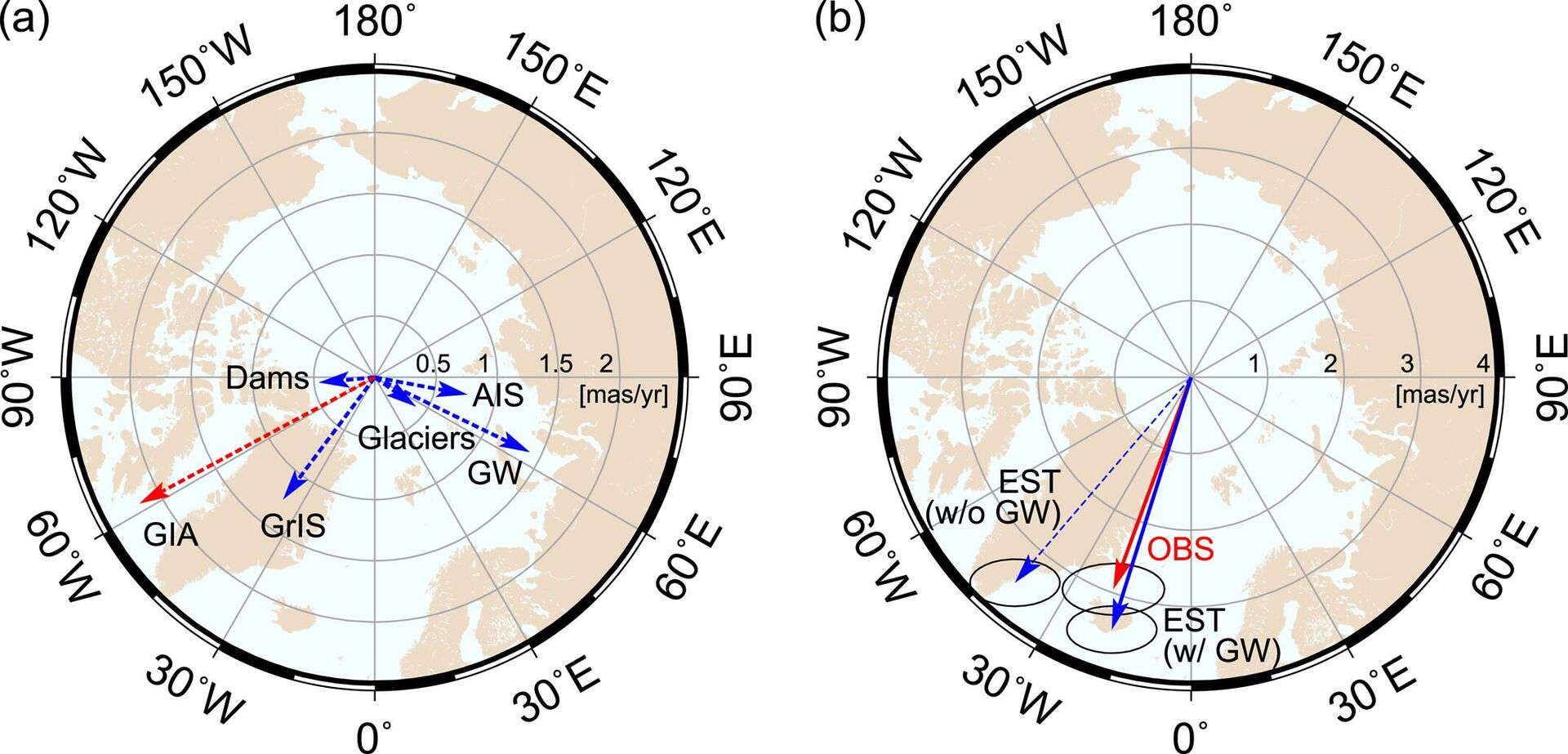https://en.sputniknews.africa/20230618/spin-me-round-earths-spin-shifted-due-to-human-groundwater-consumption-study-says-1060010876.html
Spin Me Round: Earth’s Spin Shifted Due to Human Groundwater Consumption, Study Says
Spin Me Round: Earth’s Spin Shifted Due to Human Groundwater Consumption, Study Says
Sputnik Africa
Earth spins once roughly every 24 hours at an axial tilt of 23.4°, currently declining in a 41,000-year cycle. In 2016, it was found that water might alter how... 18.06.2023, Sputnik Africa
2023-06-18T18:28+0200
2023-06-18T18:28+0200
2023-06-18T18:28+0200
science
earth
water resources
water desalination
research
https://cdn1.img.sputniknews.africa/img/07e7/06/12/1060013276_0:0:1920:1080_1920x0_80_0_0_055ad3d0c360e16638cce38c9f293445.jpg
Humans have extracted such a large mass of water from the ground that the Earth tilted nearly 80 centimeters east between 1993 and 2010 alone, according to a new study published in Geophysical Research Letters.The study in the journal of science NGO AGU for short-format, high-impact research with implications spanning the Earth and space sciences previously calculated that between 1993 and 2010, humanity pumped 2,150 gigatons of groundwater, or more than six millimeters of sea level increase, based on climate models. The quantity, however, is difficult to empirically test, scientists noted.One method involves using the Earth's rotating pole, which is where the planet revolves. When the Earth's rotational pole's position varies with respect to the crust, a mechanism known as polar motion causes it to shift. The distribution of mass on the globe is influenced by the amount of water present. The Earth spins a little bit differently as water is shifted around, similar to adding a tiny amount of weight to a spinning top.In the current study, scientists used computer simulations to depict the reported changes in the drift of the Earth's rotational pole and the movement of water, initially simply taking into account ice sheets and glaciers and then including several scenarios of groundwater redistribution.According to Surendra Adhikari, a scientist at the US Jet Propulsion Laboratory who conducted the 2016 research on the effects of water redistribution on rotational drift, the quantification of the groundwater pumping's role on polar motion is "pretty significant."How much groundwater could alter polar drift depends on where it is; water redistributing from the midlatitudes has a greater effect on the rotational pole. The two midlatitude regions of western North America and northwest India had the greatest water redistribution throughout the research period.Seasons are not likely to change as a result of changes brought on by groundwater pumping because the rotational pole often shifts by several meters over the course of about a year. Adhikari noted that polar drift can affect the climate on geologic time spans. The next stage of this investigation might involve looking back in time, the scientists claimed.
https://en.sputniknews.africa/20230607/1059762698.html
earth
Sputnik Africa
feedback@sputniknews.com
+74956456601
MIA „Rossiya Segodnya“
2023
News
en_EN
Sputnik Africa
feedback@sputniknews.com
+74956456601
MIA „Rossiya Segodnya“
Sputnik Africa
feedback@sputniknews.com
+74956456601
MIA „Rossiya Segodnya“
science, earth, water resources, water desalination, research
science, earth, water resources, water desalination, research
Spin Me Round: Earth’s Spin Shifted Due to Human Groundwater Consumption, Study Says
Kirill Kurevlev
Managing Editor
Earth spins once roughly every 24 hours at an axial tilt of 23.4°, currently declining in a 41,000-year cycle. In 2016, it was found that water might alter how the Earth rotated, but up until now, the precise role of groundwater in these rotational shifts had not been studied.
Humans have extracted such a large mass of water from the ground that the Earth tilted nearly 80 centimeters east between 1993 and 2010 alone, according to a new study published in
Geophysical Research Letters.
The study in the journal of science NGO AGU for short-format, high-impact research with implications spanning the Earth and space sciences previously calculated that between 1993 and 2010, humanity pumped
2,150 gigatons of groundwater, or more than six millimeters of sea level increase, based on climate models. The quantity, however, is difficult to empirically test, scientists noted.
One method involves using the Earth's rotating pole, which is where the planet revolves. When the Earth's rotational pole's position varies with respect to the crust, a mechanism known as polar motion causes it to shift. The distribution of mass on the globe is influenced by the amount of water present. The Earth spins a little bit differently as water is shifted around, similar to adding a tiny amount of weight to a spinning top.
"Earth's rotational pole actually changes a lot," Ki-Weon Seo, a geophysicist at Seoul National University and main author of the research is quoted in the press release as saying. "Our study shows that among climate-related causes, the redistribution of groundwater actually has the largest impact on the drift of the rotational pole."
In the current study, scientists used computer simulations to depict the reported changes in the drift of the Earth's rotational pole and the movement of water, initially simply taking into account ice sheets and glaciers and then including several scenarios of groundwater redistribution.
Only after researchers included 2,150 gigatons of groundwater redistribution did the model match the observed pole drift. Without it, the model was off by 78.5 cm, or 4.3 cm of drift annually.
"I'm very glad to find the unexplained cause of the rotation pole drift," Seo said. "On the other hand, as a resident of Earth and a father, I'm concerned and surprised to see that pumping groundwater is another source of sea-level rise."
According to Surendra Adhikari, a scientist at the US Jet Propulsion Laboratory who conducted the 2016 research on the effects of water redistribution on rotational drift, the quantification of the groundwater pumping's role on polar motion is "pretty significant."
How much groundwater could alter polar drift depends on where it is; water redistributing from the midlatitudes has a greater effect on the rotational pole. The two midlatitude regions of western North America and northwest India had the greatest water redistribution throughout the research period.
Theoretically, efforts by nations to reduce groundwater depletion rates, particularly in those vulnerable areas, could affect the change in drift, but only if such conservation measures are maintained for decades, according to the study.
Seasons are not likely to change as a result of changes brought on by groundwater pumping because the rotational pole
often shifts by several meters over the course of about a year. Adhikari noted that polar drift can affect the climate on geologic time spans. The next stage of this investigation might involve looking back in time, the scientists claimed.
"Observing changes in Earth's rotational pole is useful for understanding continent-scale water storage variations," Seo said. "Polar motion data are available from as early as the late 19th century. So, we can potentially use those data to understand continental water storage variations during the last 100 years. Were there any hydrological regime changes resulting from the warming climate? Polar motion could hold the answer."



